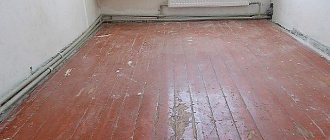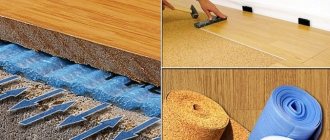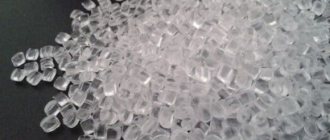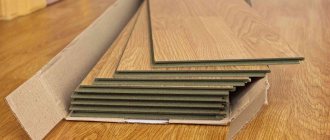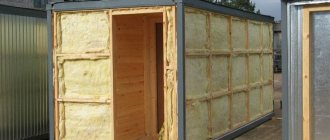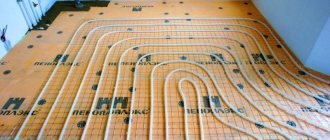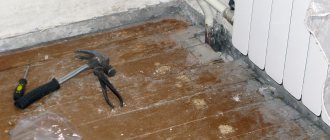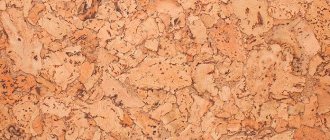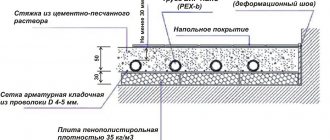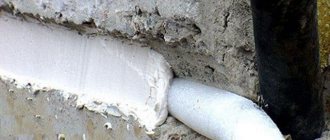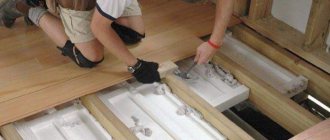The use of expanded polystyrene as thermal insulation during repairs and construction has recently become increasingly popular.
This is easily explained by the excellent performance properties of penoplex and the ease of its installation.
Due to the fact that insulation boards have a high level of rigidity, some decide that it can be used as a rigid base for decorative finishing. Let's look into this issue and consider whether it is possible to lay laminate on penoplex.
Advantages and disadvantages of insulation
Being a high-tech building material, penoplex, due to its cellular structure, has excellent thermal insulation qualities.
At the same time, it is not afraid of moisture and has sufficient fracture strength.
Such properties make it possible to construct a frameless insulation layer from foam boards.
If the installation technology is followed, the insulation will also create an additional sound insulation barrier.
The advantages of insulation include:
- zero level of water absorption;
- ease of installation;
- environmental friendliness: safe to use and non-toxic;
- with proper installation, the service life is more than 50 years.
The undoubted advantage of the material is that installation of insulation boards is possible on:
- floor slabs or concrete base;
- board or plywood flooring;
- compacted soil.
Among the shortcomings there is only one - high cost.
Properties of penoplex boards of various brands
| Penoplex brand, properties | 31 | 31С | 35 | 45.45С |
| Density (kg/m3) | 28-30.5 | 25-30.5 | 28-37 | 35-45 |
| Compressive Strength(MPa) | 0.20 | 0.20 | 0.21 | 0.41 – 0.50 |
| Flexural strength (MPa) | 0,25 | 0,25 | 0.4 | 0.4-0,7 |
| Water absorption coefficient, % | 0.4 | 0.4 | 0.4 | 0.2 – 0.4 |
| Fire hazard | G4 | G1 | G1 | G4 |
Of course, the advantages of the material are undeniable, but is it possible to immediately lay laminate on penoplex? Is it suitable as a solid base?
Types and characteristics of polystyrene foam substrate
Polystyrene belongs to a group of synthetic polymers collectively called foam. Obtained by polymerization of styrene. The output is translucent granules, from which finished products are obtained by injection molding (pressed polystyrene) or extrusion at +190-230 degrees Celsius (expanded polystyrene).
Polystyrene granules.
The production of the substrate occurs by extruding polystyrene granules mixed with foaming reagents (volatile petroleum products and water vapor), under enormous pressure and high temperature. The result is polystyrene foam with a low density (30-40 kg/m2), moisture absorption of 0.08%, thermal conductivity of 0.035 W/(MxK) and a high level of noise absorption (up to 22 dB).
The substrate for the polystyrene foam laminate is available in the form of slabs (individual sheets or accordion) or rolls.
- width - 50.0-60.0 cm;
- length - 100.0-120.0 cm;
- thickness - 2, 3, 5 mm.
Sheet backing made of polystyrene foam.
Sold in packs of 10 or 20 sheets. Sellers do not open the packaging, so you won’t be able to buy one or two sheets. Roll material is produced 15 m long, 110 cm wide, 2 mm thick.
The backing made of extruded polystyrene foam under the laminate can also be foil-coated, when the foam and foil are glued together. Available in sheets. Possesses:
- noise absorption - up to 23 dB;
- dynamic strength (impact) - 0.035 W/m2;
- bending strength - 0.25 MPa;
- thermal conductivity - 0.035 W/(MxK);
- compressive strength - 0.16 MPa.
Floor installation using penoplex insulation
Insulation boards are not recommended for use as a solid base for finishing, so the answer to all previous questions is one - no.
For any base, another layer should be placed on top of the penoplex, which will distribute the force of gravity evenly over the entire floor area.
This layer can be concrete pouring or plywood flooring.
Be sure to lay another layer of material on top of the foam.
If you try to save money in this matter, the flooring will not last long. Both laminate and penoplex are subject to point squeezing.
That is, if a chair or cabinet stands on such a floor for a long time, the legs will leave a significant dent in the laminate and destroy the structure of the foam boards.
Advantages and disadvantages
Like any building material, the substrate for polystyrene laminate (more precisely, expanded polystyrene) has its advantages and disadvantages in comparison with similar materials. The advantages include:
- the ability to maintain elasticity due to the high strength of the molecular bonds of the material during compression, as a result of which the floor covering retains its integrity and beauty for a long time;
- long service life, coinciding with the service life of the laminate;
- absence of deformation during prolonged exposure to heavy objects (under the legs of furniture, the polystyrene backing is able to restore its dimensions over a long period of time);
- high thermal insulation properties - the porous structure conducts heat poorly;
- good level of noise absorption - up to 70% or 22 dB;
- retains its properties in a wide temperature range - from -50 to +75 degrees Celsius, which allows polystyrene material to be laid under laminate or linoleum in unheated rooms (dachas);
- the ability to ensure air circulation on the concrete surface of the screed or waterproofing material (ribbed underside), as a result of which condensation does not form under the laminate;
- environmentally friendly - safe for the environment (does not rot);
- quality corresponds to price;
- the ability of the cellular structure to prevent the formation of condensation, and when it occurs, to absorb moisture, which makes it possible not to waterproof the floor screed;
- accuracy of sheet dimensions in length and width, which simplifies the installation process;
- light weight and compact packaging, allowing the polystyrene foam pad to be transported in passenger cars.
There are also disadvantages, but very few:
- low leveling ability - with a thickness of 3 mm, it is not able to eliminate the impact of irregularities of more than 1 mm on the flooring, as a result of which creaking quickly appears;
- has a temporary drawdown that will go away in 4-5 weeks;
- not sold in sheets, but only in packages, as a result of which quite often a large balance arises - a loss of the family budget;
- low resistance to aggressive environments (easily dissolves in gasoline, acetone, chloroform, etc.), with the exception of ammonia, alkalis, alcohol, propane;
- highly flammable due to the high content of carbon (92%) and hydrogen (8%) in the composition;
- in packages, sheet material is constantly curved;
- fragility of the substrate under strong bending.
Testing polystyrene foam for flammability.
Laying on compacted soil
The design thickness of such a flooring cake is 60-70 cm. The base soil must be dry and it must be thoroughly compacted.
Alternately pour a layer of crushed stone more than 30 cm thick, a layer of fine-grained sand about 10 cm - both layers are thoroughly compacted.
Below is the step-by-step work:
- Penoplex sheets are installed. The thickness of the material is chosen to be the greatest that can be laid at the floor level.
- The joining seams are taped with construction metallized tape.
- A waterproofing film is laid.
- A fiberglass mesh is laid to give the screed additional rigidity.
- A concrete layer more than 5 mm thick is poured.
It is better to use sheets with joining grooves along the edges. If it is not possible to purchase thick material, then thin slabs are mounted in 2 layers with the flooring perpendicular to the direction.
In this case, the top layer should be glued together at the seams. The composition of the screed depends on the planned finishing coating. To learn how these manipulations are carried out, watch this video:
Installation on a concrete base
When insulating a concrete base, it is necessary to check the quality of the floor and, if necessary, eliminate all irregularities and cracks.
If the quality of the surface is not satisfactory, then it should be cleaned of construction debris, dust and treated with a deep penetration primer.
If work is carried out on the ceiling of the first or basement floor in a house with a basement, it is better to cover the base with polyethylene film before laying the penoplex. The film strips are laid overlapping, the seams are secured with construction tape.
Insulation of wooden floors
The situation is quite rare. The construction of the structure on logs allows the use of budget building materials for insulation, because the main and most valuable quality of penoplex is rigidity; in such a floor it does not matter at all.
The exception is the installation of insulation over a plank floor and the installation of floors on joists in a house on stilts. In the latter case, insulation is done according to the following scheme:
- the rough flooring is being laid from boards;
- film waterproofing is laid;
- Penoplex is laid with shifts along the seams;
- insulation boards are screwed around the perimeter of each sheet to the rough base;
- seam gaps are filled with foam;
- a vapor barrier is placed on the insulation;
- lay the sheet base over the finishing coating. For more information about floor insulation using joists, watch this video:
When laying insulation on an old plank floor, it is necessary to secure all the boards to the joists: the floors should not sag or creak. Rotten or damaged boards should be replaced. Wooden floors should be treated with at least 2 coats of primer. Penoplex is laid on the dried base. Further, all work is carried out by analogy with a house on a pile foundation.
Insulating the floor with penoplex is a common suggestion today. This heat insulator is chosen because of its low thermal conductivity, the ability to get by with a small thickness, as well as high compressive strength, which makes it possible to do without additional reinforcement when installing floors. They insulate floors laid on the ground, floors above basements, floors on floors, balconies and loggias. The material is also popular because the price of foam floors and screed is relatively affordable. As a finishing coating, tiles and veneer boards are installed, a screed with a “warm floor” system is installed, and penoplex is placed under the laminate and linoleum.
Recommended Posts
Recently viewed by 0 users
No registered user is viewing this page.
The best articles on the IVD website
Are you a professional architect or designer?
IVD. Repair and finishing
Are you a professional architect or designer?
The IVD.ru website is a leading Internet project dedicated to the issues of reconstruction and interior design of residential premises. The main content of the site is the archive of the magazine “Ideas for Your Home” - exclusive author’s articles, high-quality illustrations, practical tips and lessons. A team of professionals is working on the project in close collaboration with famous designers, architects and leading publishing experts.
On our website you can choose comprehensive design solutions; view detailed reviews of the market for construction and finishing materials, furniture, machinery and equipment; compare your own ideas with design projects of leading architects; communicate directly with other readers and editors on the forum.
Are you a professional architect or designer?
Insulating the floor with penoplex is a common practice today. The thermal insulator is chosen due to its low thermal conductivity, the possibility of a small thickness, as well as high compression strength, which makes it possible to do without additional reinforcement when installing floors. They are used to insulate constructed floors, floors on the ground, floors above basement floors, rooms on floors, balconies and loggias. The material is also popular because the price of penoplex flooring and screed is relatively affordable. As a finishing coating, tiles are installed, veneered ones are installed, screed boards with a “warm floor” system, penoplex are placed under laminate and linoleum.
Penoplex - a warm base for the floor
There are many floor insulation technologies. This includes expanded clay, mineral wool, and, of course, penoplex. The latter is one of the best modern heat insulators, although, it should be noted, not the cheapest. To insulate the floor, a 20-30 mm slab is sufficient (on the first floors it can be increased to 50 mm), while the thickness of mineral wool, for example, is recommended to be twice as thick.
- The advantages of penoplex for floor insulation are as follows:
- Excellent moisture-proofing properties
- Good thermal insulation
- Mechanical strength
- Durability
- Easy installation
Before installing the laminate on Penoplex, you need to lay the insulation itself. This is quite easy to do. It all depends on what kind of leveling screed it will be - cement or made of sheet material (plywood, OSB, GVL). For one you will need as smooth a rough surface as possible, for the other you will have to lay down wooden logs as a base for the coating.
Under a cement screed on penoplex, on which the laminate will then be laid, it is better to choose slabs with grooves at the ends for tighter joints. If the system requires the presence of wooden logs, then the heat insulator can be taken without a curved edge.
Penoplex insulation is not a substrate for laminate! Do not confuse it with the backing made of extruded polystyrene foam. When laying laminate flooring on penoplex, a screed, dry or cement, must be installed.
Installation of penoplex under laminate with concrete screed
- Prepare penoplex laminate with screed as follows:
What insulation is better to put under laminate
You can insulate the floor under the laminate in your home using different materials. When choosing, a number of factors are taken into account, including the complexity of the work, its costs, and the expected effect.
Expanded clay
Expanded clay is a bulk building material. It is made from low-melting clay by firing.
This insulation has many advantages:
- low price;
- lightness due to the porous structure;
- maximum filling of space;
- strength;
- durability;
- fire resistance;
- no toxicity;
- resistance to low temperatures, fungi;
- reduction in screed weight.
Thanks to these properties, expanded clay is suitable not only for residential premises, but also for insulating floors on balconies under laminate. The material can be added to concrete or used in other ways:
- Dry screed. This option is used for concrete floors. A layer of expanded clay is poured, then a screed is made, a substrate is laid and the laminate is laid.
- Insulation with logs. The beams are installed, expanded clay is poured between them, fiberboard or chipboard is laid on top, and the laminate is laid on the substrate.
For insulation and leveling the floor, expanded clay with a fraction of 5-10 mm is better - it is called gravel. Note! You should work with expanded clay using a respirator. This is only dust protection, the material is safe for health.
Foil and glass wool
Glass wool is a type of mineral wool made from molten glass. The material can be rolled or in the form of plates. It has good thermal insulation and other advantages:
- high elasticity, chemical resistance;
- low price;
- ease;
- durability;
- lack of flammability;
- continuous coating;
- good sound insulation;
- no susceptibility to fungi or mold.
The disadvantages of glass wool include unsafe operation and shrinkage, which increases when moistened. High-quality insulation should restore its original appearance when deformed.
It is better to use glass wool with a layer of foil. This allows you to reduce the thickness of the insulation layer. Place the material between the joists, then lay chipboard or plywood.
Floor foil can be used in rolls or slabs. The material has several advantages:
- good thermal insulation - up to 95-97% of thermal radiation is reflected into the room;
- long service life;
- resistance to moisture;
- noise absorption;
- environmental friendliness;
- elasticity.
It is important to correctly place the foil insulation under the laminate. The reflective side should be directed into the room.
Foil mineral wool is often used for non-residential premises. The material is not afraid of temperature changes and is not flammable. It can be used on uneven and curved surfaces. The thickness of foiled glass wool is usually 5-10 cm.
Foil glass wool is laid with the reflective side up; no additional vapor barrier is required
Styrofoam
Polystyrene foam is a foamed plastic mass. It has many advantages:
- thermal insulation;
- sound absorption;
- low cost;
- ease of processing and installation;
- light weight.
Polystyrene foam can be used to insulate the floor on a loggia or balcony under laminate, and can be used in residential premises. The material is not afraid of moisture or temperature changes. There are several options for using insulation:
- Foam boards for screed. Make a small layer on top of the foam panels laid on the concrete floor. After drying, proceed to finishing with laminate.
- Adding granular foam to concrete mortar. Uniform distribution of insulation is important.
- Laying foam boards between joists. For ease of installation, the interval between the beams must correspond to the dimensions of the insulation. After placing it, shields are installed on the logs, then they begin laying the laminate.
- Liquid foam plastic (penoizol). It is placed between the logs, after drying the mass becomes porous. The material is not hygroscopic, not susceptible to rodents, fungi, mold.
Comment! You need to work with penoizol in special clothing, using a respirator, gloves and goggles. Harmful substances are released only before polymerization, after which the material is safe.
Penoizol has higher thermal insulation than classic polystyrene foam and mineral wool
Coniferous slabs
Such boards are an environmentally friendly material - no glue, modifiers, or other additives are used in their production. They have several advantages:
- thermal insulation;
- sound absorption;
- masking small irregularities;
- low cost;
- ease of installation processing.
Coniferous underlay under laminate can be used as insulation for both wooden and concrete floors. There is no need to fix the boards with glue.
The coniferous substrate is a breathable material, therefore it allows moisture to pass through without accumulating it. The downside is that this property does not prevent the formation of mold. Coniferous boards should not be used in rooms with high humidity. It is important to lay them on a completely dry surface.
Coniferous slabs are laid diagonally; if desired, tape can be used for fixing
Cork substrates
Cork backing for laminate can be sheet or roll. The color of the material is usually light brown. The advantages are as follows:
- thermal insulation;
- wear resistance;
- durability;
- ease of processing and installation.
The cork backing can be natural or synthetic rubber. There is an option based on kraft paper with the addition of bitumen and spraying of fine cork shavings.
Comment! Cork underlayment is not suitable for heated floors. Due to temperature changes, it will shrink and swell and quickly collapse.
Among the disadvantages of cork substrate is hygroscopicity - if moisture gets in, mold may appear.
Penoplex and laminate underlay
As you know, when laying the coating, a substrate is used - cork or polyethylene foam. Is it possible to lay laminate flooring on penoplex without a backing? Many “craftsmen,” as practice shows, are tempted to lay laminate flooring on polystyrene foam without any screeds. It seems that the material is durable, why bother with the screed? Such a floor will only bring problems.
Penoplex is not designed for point loads; its strength makes itself felt under static pressure. The heat insulator, according to the rules, placed under the screed, can withstand enormous weight, and at the same time it is easy to make a hole in it, even with a pencil. And most pieces of furniture are the same point load.
An unsuccessfully placed cabinet, with its leg caught on the lock of the laminate board, can simply fall into the floor. The foam underlay under the laminate will not save you from destruction - it will be of little use, it is designed to protect from noise and moisture, and not to reinforce the base. In addition, such a coating will creak terribly.
When insulating and covering the floor, it is still better to abandon “folk inventions” and rely on existing technologies. But they claim that it is impossible to install laminate directly on penoplex. It’s better to follow all the instructions and end up with a warm and beautiful floor than to start a new renovation six months later, correcting your own mistakes.
Penoplex is one of the most popular insulating materials. Its main advantage is ease of use. Any person, even those who do not have construction skills, can insulate the floor with penoplex with their own hands. This universal material is suitable for insulating apartments, loggias, balconies and private houses. It can be laid on concrete, wood and soil foundations.
Why do you need insulation for laminate flooring?
Laminate is made from fiberboard with a lining - a film based on thermosetting polymers. This coating is cooling, which is especially noticeable on the first floors, balconies and loggias, in private houses and cottages. Those who like to walk barefoot where there are children and pets should think about floor insulation. This measure not only saves from the cold and provides comfort, but can also solve other problems:
- saving on heating;
- additional sound insulation;
- reduction of condensation formation under the laminate;
- prevention of mold development;
- leveling the floor - for laminate flooring this factor is very important; minimal differences are allowed.
Most manufacturers' requirements include the use of a vapor barrier film. The insulation is placed between it and the laminate.
Description of penoplex
The material is based on foamed polystyrene. Unlike polystyrene foam, it has a dense and elastic structure. Penoplex holds air well and does not allow water to pass through, so it is used to insulate both heated and unheated rooms. Many experts note excellent protection from the cold when insulating floors with penoplex.
There are different types of material that differ in density, thickness and fire resistance. The usual width of the slabs is 600 mm, length - 1200 or 2400 mm. They have a thickness from 20 to 100 mm. The insulation is sold in packs of 4-20 sheets.
Penoplex has the following advantages:
This video will tell you how to insulate the foundation of a building with penoplex with your own hands:
Well-laid penoplex protects from low temperatures, noise, moisture, and creates comfortable living conditions. Its disadvantages include low resistance to solvents and high temperatures.
Thick and dense penoplex is used in places where good thermal insulation is required. It is often used in construction. It insulates floors with a concrete or soil base well. Often the material is laid in 2 layers.
Depending on the part of the house to be insulated, the thickness of the penoplex is selected
Self-installation
The insulation is mounted on foundations made of reinforced concrete, soil and wood. When working, the following rules should be observed:
- strictly follow the installation instructions;
- Carefully adjust the slabs to each other so that there is no free space between them.
- Distortions and rolls are unacceptable.
If the material is laid in two layers, then you need to ensure that the joints of the upper plates do not coincide with the joints of the lower ones. Otherwise, pockets filled with air will appear in the insulating layer. Condensation will accumulate in them. Such defects impair thermal insulation and subsequently lead to delamination of the insulation.
A special compound is used to glue the boards together. It improves the thermal insulation properties of insulation. A “finish floor” is laid on top of the penoplex, for which the following materials are used:
- laminate;
- linoleum;
- parquet;
- polymer coating;
- ceramic tiles;
- boards.
Decorative coating is mounted on foam boards
Laying rules
In order to place extruded polystyrene foam under the laminate , no additional fastening materials or special skills are required.
The main rule is that the seams of the substrate and the laminate do not match. To do this, polystyrene foam is laid at an angle of 45 degrees. Sheets with a thickness of 3 mm of various colors and manufacturers are used as a substrate. First of all, the surface should be leveled and free of dirt. Next, the sheets of expanded polystyrene are laid tightly next to each other in a checkerboard pattern.
It has long been noticed that people pay much less attention to secondary things than to the main ones. This also applies to installing laminate flooring in an apartment: it takes a long time to select a lamella strip and, almost without hesitation, buy a backing for it. Considering that foam polystyrene substrates are among the leaders in popularity, let’s consider how justified this is.
Ground mounting
Penoplex is widely used to insulate earthen floors. Floors on the ground are installed as follows:
- Carefully level the installation site.
- Cover it with expanded clay and sand to a height of 40 cm. The layers should be positioned strictly horizontally.
- Insulation boards with a thickness of 5 cm or more are laid. The sheets are carefully joined together, leaving no gaps. The joints are sealed with tape.
Penoplex can be used to effectively insulate an earthen floor
Installing a floor in a bathhouse has its own characteristics. Here the screed is installed at an angle to ensure water drainage. To cover the floor, it is better to use sanded boards mounted on joists.
Installation on a finished base
To properly insulate the floor with penoplex, you first need to remove the old floor covering: linoleum, tiles, laminate, boards. Otherwise, the new coating will inherit all the defects of the old one. After this, carefully inspect the concrete base. Correct all imperfections: cracks, chips, unevenness. To level the surface, you can use a small layer of filler floor.
Before laying foam boards, it is advisable to dismantle the old floor covering
Insulation is laid on a flat base. Its installation is carried out using a special glue that does not corrode penoplex. Waterproofing is laid on top of the insulation, and then a concrete screed is made.
The floor insulation on a balcony or loggia is carried out in the same way. The old floor covering is removed, the concrete base is leveled, insulation, waterproofing and a layer of concrete screed are laid. If a balcony or loggia is located above the first floor, then for insulation it is enough to use foam sheets 3 cm thick. The concrete screed can have the same thickness.
For a small balcony or loggia, instead of a cement screed, you can use any waterproof material of sufficient rigidity. For loggia walls, thin foam sheets can also be used as insulation.
Types of insulation
The base for laying the laminate can be wooden or concrete. Depending on this, insulation for the floor under the laminate is selected. Expanded clay is used as insulation for wooden floors. For better insulation, its layer should be at least 10 cm.
Other types of insulation are also produced that can be laid on wooden and concrete floors:
- Polystyrene foam is an insulation material that has a grainy texture that is filled with air. It is very light, practical, and has excellent thermal insulation and sound insulation qualities.
- Expanded polystyrene – levels the base for laying the finishing coating.
- Polyurethane foam . There are two types: poured and sprayed. Slightly absorbs moisture and retains heat. Work on insulation with such material requires special equipment, in this case it is better to hire craftsmen.
- Mineral wool is an inexpensive and long-lasting material. After installation, this insulation must be covered with foil or metallized film.
- Ecowool is similar in structure and qualities to mineral wool, but is made from cellulose fibers, and therefore does not harm human health.
- Foil is available in two forms: slabs and rolls. Should be laid with the reflective side down.
- Cork is the most expensive insulation material, but it is environmentally friendly, reliable and wear-resistant.
- A substrate made of plywood , oriented strand board (OSB), gypsum fiber sheet (GVL - more details: “How to lay GVL on the floor - examples from practice”), fiberboard (Fiberboard), chipboard (chipboard) - will allow for compressed deadlines and at the same time make the floor smooth and warm.
